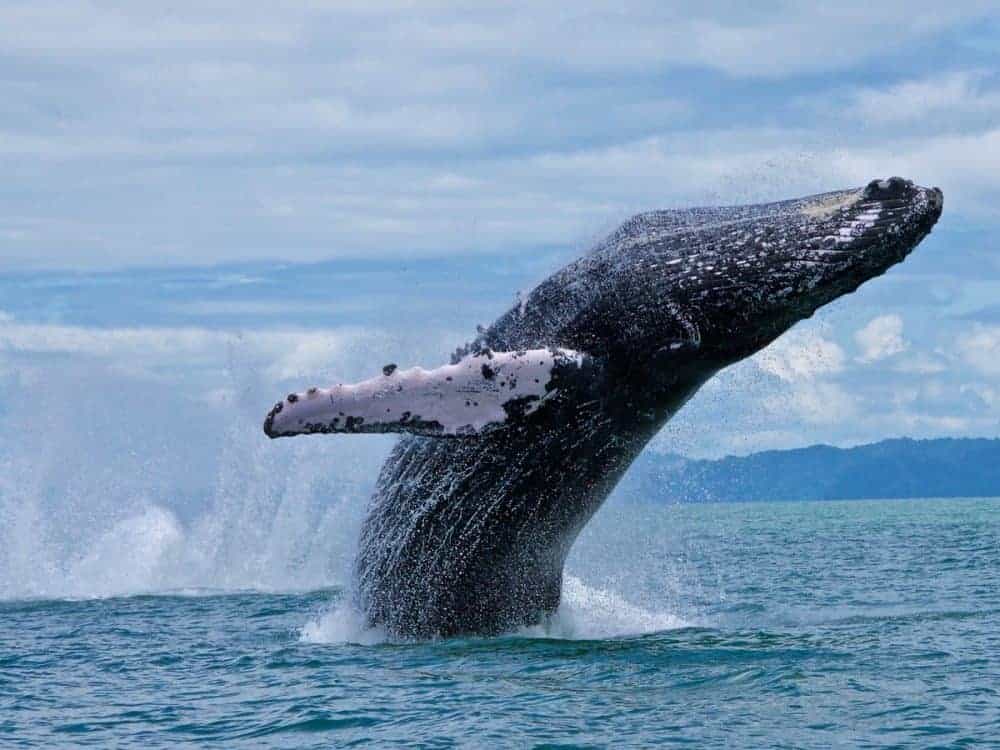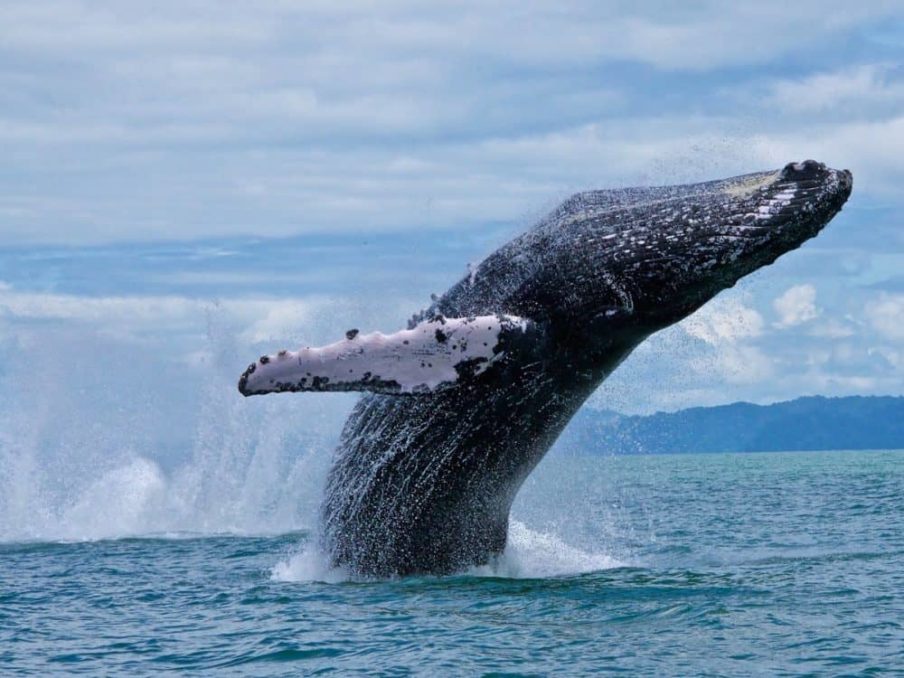
Seeing humpback whales in their natural habitat is a bucket-list experience, and Costa Rica offers one of the best places in the world to witness these gentle giants. With warm tropical waters, stunning coastlines, and a commitment to conservation, this country is a haven for humpback whales and the travelers eager to spot them.
In this guide, we’ll cover when and where to see humpback whales, what to expect on a tour, and how to choose a responsible operator, so you can plan a trip that’s as unforgettable as it is ethical.
Humpback Whale Migration: A Year-Round Spectacle
Costa Rica’s unique position near the equator makes it a prime destination for humpback whales, with sightings possible for up to nine months of the year. Two distinct groups visit the country’s waters, each escaping their respective winters to breed, give birth, and nurse their young in Costa Rica’s warm, sheltered bays.
Northern Hemisphere Humpbacks
From December to April, whales from California and the northwestern U.S. migrate south to the Pacific coast. These whales, numbering around 1,000, seek out areas like Guanacaste and Marino Ballena National Park to raise their calves in predator-scarce waters.
Southern Hemisphere Humpbacks
From mid-July to November, Antarctic whales travel up to 5,000 miles from Chile and the Antarctic Peninsula to Costa Rica’s South Pacific. This group, often seen in larger pods of about a dozen, favors spots like the Osa Peninsula and Golfo Dulce for breeding.
The warm waters are ideal for newborn calves, which can grow from 13-16 feet at birth to over 26 feet in their first year, feeding on rich milk while adults fast. August to October is the peak for Southern Hemisphere whales, offering the highest sighting chances, while January and February are prime for Northern whales. This dual migration gives Costa Rica the longest humpback whale season globally, making it a must-visit for marine life enthusiasts.
Top Spots for Whale Watching
Costa Rica’s Pacific coast is the heart of whale-watching activity, with several regions offering unique experiences. Here are the best places to catch a glimpse of humpback whales, along with other marine life like dolphins, sea turtles, and rays.
Guanacaste: The Northern Gem
Guanacaste, on the northwestern Pacific coast, is a whale-watching hotspot with crystal-clear waters and vibrant marine ecosystems. While dedicated whale-watching tours are less common here, humpbacks are often spotted on snorkeling, catamaran, or diving trips in the Gulf of Papagayo, especially from July to September and December to February.
Playas del Coco and Tamarindo are great bases, with boats venturing to sites like the Las Catalinas Islands, where whales sometimes breach dramatically. The region’s beaches and abundant dolphins add to the appeal, though sightings in December can be less reliable due to migration overlaps.
Marino Ballena National Park: The Whale Haven
Located near Uvita on the South Pacific coast, Marino Ballena National Park is arguably the best place in Costa Rica for whale watching, ranked by National Geographic as one of the top 10 global spots. Named for the humpback whales (“ballena” in Spanish), the park protects 13,000 acres of ocean and features a unique Whale’s Tail sandbar, visible at low tide.
Both Northern (December-April) and Southern (July-November) humpbacks flock here to breed, with August to October offering the highest sighting rates. Tours from Uvita, often on small boats carrying 15-25 passengers, also include snorkeling and visits to Ballena Island, a bird sanctuary. The park’s coral reefs and mangroves make it a biodiversity hotspot, home to spotted dolphins, sea turtles, and manta rays.
Osa Peninsula and Golfo Dulce: The Southern Sanctuary
The Osa Peninsula, particularly Drake Bay and Golfo Dulce, is a biodiverse paradise where humpbacks gather in shallow, protected waters. Golfo Dulce, a tropical fjord, is a key breeding ground for Southern Hemisphere whales from August to October, with sightings of mothers and calves basking together. Tours from Drake Bay often combine whale watching with snorkeling or hikes in Corcovado National Park. This remote region offers a more intimate experience, though it requires extra travel from San José.
Manuel Antonio: The Central Coast Surprise
Manuel Antonio National Park, known for its beaches and rainforest, is also a whale-watching contender. Humpbacks are spotted off the coast from June to August, often during catamaran or snorkeling tours. While not as whale-focused as Uvita, the area’s accessibility from San José (a 3-hour drive) and vibrant wildlife make it a great add-on for travelers.
| Location | Best Time to Visit | Key Features | Tour Highlights |
|---|---|---|---|
| Guanacaste | Jul-Sep, Dec-Feb | Gulf of Papagayo, dolphin sightings | Snorkeling, catamaran tours |
| Marino Ballena National Park | Jul-Nov, Dec-Apr | Whale’s Tail sandbar, coral reefs | Whale watching, snorkeling, birding |
| Osa Peninsula/Golfo Dulce | Aug-Oct | Remote, biodiverse, calm waters | Whale watching, Corcovado hikes |
| Manuel Antonio | Jun-Aug | Rainforest, beaches, accessible | Catamaran tours, wildlife spotting |
What to Expect on a Whale-Watching Tour
Whale-watching tours in Costa Rica are as much about the journey as the whales themselves. Most tours last 3-5 hours and cost $50-$150 per person, depending on the operator and inclusions like snorkeling or lunch. You’ll board a small outboard skiff or a larger fishing boat, often departing from beaches in Uvita, Drake Bay, or Playas del Coco. Guides share insights on humpback behavior, migration, and local ecosystems, pointing out dolphins, sea turtles, or seabirds along the way.
When whales appear, it’s pure magic. Humpbacks, weighing 15-30 tons, move with surprising grace, breaching, tail-slapping, or swimming alongside their calves. Their “songs”—complex vocalizations used by males to attract mates—can sometimes be heard with hydrophones, though this isn’t guaranteed on every tour.
You’ll stay a safe distance (at least 100 meters per Costa Rican regulations) to avoid disturbing them, but the view is still awe-inspiring. Tours in Marino Ballena may also pause for snorkeling near coral reefs or a pass by Ventanas Beach’s sea caves. Bring sunscreen, a hat, and a camera, as sightings of breaching whales or playful dolphins are photo-worthy moments.
Choosing a Responsible Tour Operator
Responsible tourism is key to protecting Costa Rica’s marine life. Humpback whales are endangered, and Costa Rica enforces strict guidelines to ensure their safety. When booking a tour, look for operators who:
- Maintain a 100-meter distance from whales and limit observation to 30 minutes per group.
- Avoid chasing or crowding whales, with a maximum of two boats per group.
- Prohibit swimming, feeding, or diving with whales, which is illegal except for researchers.
- Support conservation, such as through the Costa Rican Coalition for Whales, which trains guides in sustainable practices.
Reputable operators, like those in Uvita or Drake Bay, prioritize education and safety, offering insights into whale behavior while respecting their space. Book early, especially for August-October or January-February, as tours fill up fast. Check reviews on sites like Tico Travel or Bahia Aventuras for trusted providers.
Challenges and Conservation Efforts
Climate change poses a growing threat to whale watching in Costa Rica. Rising ocean temperatures, driven by El Niño and global warming, have reduced sightings in warmer years, as whales may find suitable breeding waters before reaching Marino Ballena. In 2015-2016, sightings dropped, impacting local tourism.
The park’s coral reefs, another draw for snorkelers, have also suffered, with 90% bleached by 2016. Conservation groups like the Keto Foundation are pushing for sustainable practices, such as rotating tour areas to reduce stress on marine habitats and planting palm trees to combat coastal erosion. By choosing eco-conscious operators, you support these efforts to preserve Costa Rica’s marine legacy.
Final Thoughts
Whale watching in Costa Rica is a humbling chance to connect with nature’s giants. Whether you’re marveling at a breaching humpback in Marino Ballena, spotting dolphins in Guanacaste, or exploring the Osa Peninsula’s wild beauty, the experience is one you’ll carry forever.
With migrations from July to November and December to April, there’s ample opportunity to plan your trip. Book with a responsible operator, pack your sense of wonder, and get ready for a front-row seat to one of the ocean’s greatest shows. Pura vida!

